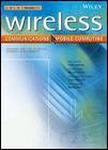版权所有:内蒙古大学图书馆 技术提供:维普资讯• 智图
内蒙古自治区呼和浩特市赛罕区大学西街235号 邮编: 010021

作者机构:Univ Florida Dept Elect & Comp Engn Gainesville FL 32611 USA
出 版 物:《WIRELESS COMMUNICATIONS & MOBILE COMPUTING》 (无线通信和移动计算)
年 卷 期:2002年第2卷第2期
页 面:205-214页
核心收录:
学科分类:0810[工学-信息与通信工程] 0808[工学-电气工程] 0809[工学-电子科学与技术(可授工学、理学学位)] 08[工学] 0812[工学-计算机科学与技术(可授工学、理学学位)]
主 题:wireless communications space-time coding smart antennas spread spectrum DS-CDMA Rake receiver
摘 要:Differential space-time modulation (DSTM) schemes were recently proposed to fully exploit the transmit and receive antenna diversities without the need for channel state information. DSTM is attractive in fast flat fading channels since accurate channel estimation is difficult to achieve. In this paper. we propose a new modulation scheme to improve the performance of DS-CDMA systems in fast time-dispersive fading channels. This scheme is referred to as the differential space-time modulation for DS-CDMA (DST-CDMA) systems. The new modulation and demodulation schemes are especially studied for the fast fading down-link transmission in DS-CDMA systems employing multiple transmit antennas and one receive antenna. We present three demodulation schemes. referred to as the differential space-time Rake (DSTR) receiver, differential space-time deterministic (DSTD) receiver, and differential space-time deterministic de-prefix (DSTDD) receiver, respectively. The DSTD receiver exploits the known information of the spreading sequences and their delayed paths deterministically besides the Rake-type combination: consequently, it can outperform the DSTR receiver. which employs the Rake-type combination only, especially for moderate-to-high SNR. The DSTDD receiver avoids the effect of intersymbol interference and hence can offer better performance than the DSTD receiver. Copyright (C) 2001 John Wiley Sons, Ltd.